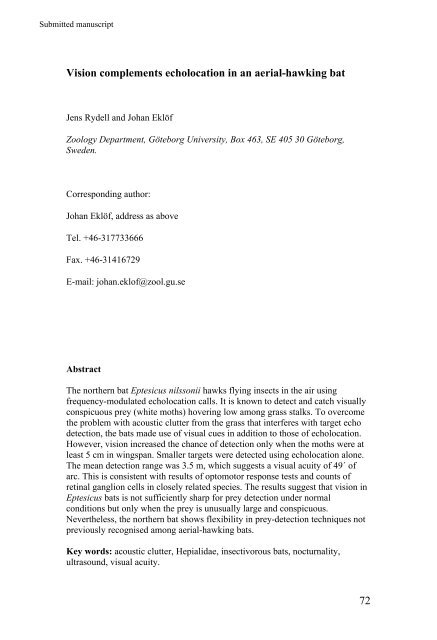Vision in echolocating bats - Fladdermus.net
Vision in echolocating bats - Fladdermus.net
Vision in echolocating bats - Fladdermus.net
You also want an ePaper? Increase the reach of your titles
YUMPU automatically turns print PDFs into web optimized ePapers that Google loves.
Submitted manuscript<br />
<strong>Vision</strong> complements echolocation <strong>in</strong> an aerial-hawk<strong>in</strong>g bat<br />
Jens Rydell and Johan Eklöf<br />
Zoology Department, Göteborg University, Box 463, SE 405 30 Göteborg,<br />
Sweden.<br />
Correspond<strong>in</strong>g author:<br />
Johan Eklöf, address as above<br />
Tel. +46-317733666<br />
Fax. +46-31416729<br />
E-mail: johan.eklof@zool.gu.se<br />
Abstract<br />
The northern bat Eptesicus nilssonii hawks fly<strong>in</strong>g <strong>in</strong>sects <strong>in</strong> the air us<strong>in</strong>g<br />
frequency-modulated echolocation calls. It is known to detect and catch visually<br />
conspicuous prey (white moths) hover<strong>in</strong>g low among grass stalks. To overcome<br />
the problem with acoustic clutter from the grass that <strong>in</strong>terferes with target echo<br />
detection, the <strong>bats</strong> made use of visual cues <strong>in</strong> addition to those of echolocation.<br />
However, vision <strong>in</strong>creased the chance of detection only when the moths were at<br />
least 5 cm <strong>in</strong> w<strong>in</strong>gspan. Smaller targets were detected us<strong>in</strong>g echolocation alone.<br />
The mean detection range was 3.5 m, which suggests a visual acuity of 49´ of<br />
arc. This is consistent with results of optomotor response tests and counts of<br />
ret<strong>in</strong>al ganglion cells <strong>in</strong> closely related species. The results suggest that vision <strong>in</strong><br />
Eptesicus <strong>bats</strong> is not sufficiently sharp for prey detection under normal<br />
conditions but only when the prey is unusually large and conspicuous.<br />
Nevertheless, the northern bat shows flexibility <strong>in</strong> prey-detection techniques not<br />
previously recognised among aerial-hawk<strong>in</strong>g <strong>bats</strong>.<br />
Key words: acoustic clutter, Hepialidae, <strong>in</strong>sectivorous <strong>bats</strong>, nocturnality,<br />
ultrasound, visual acuity.<br />
72


